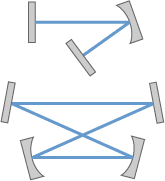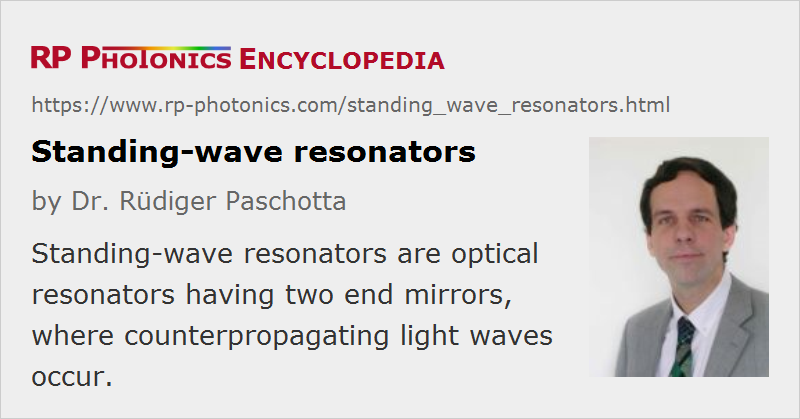Standing-wave Resonators
Definition: optical resonators with two end mirrors
Alternative term: linear resonators
Opposite term: ring resonators
German: Stehwellen-Resonatoren, lineare Resonatoren
How to cite the article; suggest additional literature
Author: Dr. Rüdiger Paschotta

Optical resonators can be made with two or more mirrors and possibly other optical components. Some of them are standing-wave resonators, also called linear resonators, where the light is reflected with normal incidence on two end mirrors. A consequence of that is that a standing wave (see Figure 2), formed by two counter-propagating optical waves, is formed within the resonator (at least in a simple situation with light in only one resonator mode). This is in contrast to the situation in a ring resonator, where standing waves may occur only in the immediate vicinity of mirrors: there, the radiation is reflected with non-normal incidence, leading to a spatial overlap between incoming and reflected wave only in a limited volume.
The resonator modes of a linear resonator are always exactly perpendicular to the end mirrors; if such a resonator is somewhat misaligned, the modes adjust their position such as to still maintain that condition.
If a linear resonator is made from two mirrors only, it can also be called a Fabry–Pérot resonator (→ Fabry–Pérot interferometers).
Standing-wave resonators can be realized not only with bulk components, but also with optical fibers.
In cases where the occurrence of standing waves is not relevant, the term linear resonator is more common. Linear resonators are often preferred over ring resonators because they are usually simpler to build and align.
Stability Zones
An optical resonator made with free-space optics (i.e., not with waveguides) can have stability zones, outside which it is an unstable resonator. While ring resonators can have only one stability zone, linear resonators generally have two of those.
The Standing-wave Pattern
The standing-wave pattern of the optical intensity can be largely washed out if the intracavity light is spread over multiple resonator modes, since the spatial pattern is somewhat different for each mode. Also, polarization effects may lead to such results; this is sometimes exploited with the twisted-mode technique.
If light is injected through an end mirror of a linear resonator (with some transmittance), part of that light is reflected back with full spatial overlap with the incident wave. That property of a linear resonator is sometimes disadvantageous, e.g. when a laser is sensitive to backreflected light. Therefore, mode cleaner cavities, for example, are often made as ring resonators, where the reflected beam is easily separated from the incident beam.

In some situations, the standing waves in a linear resonator are relevant for an application. For example, standing-wave effects in linear laser resonators can give rise to spatial hole burning, and this can make it difficult to achieve single-frequency operation for realizing a narrow-linewidth laser. Here, gain saturation in the laser gain medium (e.g. a laser crystal) is determined by the standing-wave pattern, rather than being homogeneously distributed in the medium. As a result, the gain of the lasing mode is saturated more than that of any competing modes, which are thus favored.
Questions and Comments from Users
Here you can submit questions and comments. As far as they get accepted by the author, they will appear above this paragraph together with the author’s answer. The author will decide on acceptance based on certain criteria. Essentially, the issue must be of sufficiently broad interest.
Please do not enter personal data here; we would otherwise delete it soon. (See also our privacy declaration.) If you wish to receive personal feedback or consultancy from the author, please contact him e.g. via e-mail.
By submitting the information, you give your consent to the potential publication of your inputs on our website according to our rules. (If you later retract your consent, we will delete those inputs.) As your inputs are first reviewed by the author, they may be published with some delay.
See also: optical resonators, ring resonators, spatial hole burning, laser resonators
and other articles in the category general optics
 |



If you like this page, please share the link with your friends and colleagues, e.g. via social media:
These sharing buttons are implemented in a privacy-friendly way!